Just a note that as much as I would like to have a review of the Marble Craze homebrew in this space, I do not currently have any way to play it (I do not yet own the cart, the game requires two paddles and I have no idea how to translate that in emulation). I will get to it as soon as I can. As compensation, this entry features six reviews compared to the usual five. Also, sorry I missed Maze Craze in this entry – it’ll be at the top of the next one.
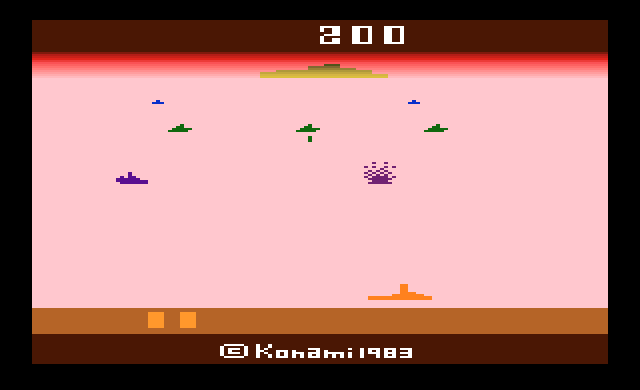 Marine Wars (Konami, 1983)
Marine Wars (Konami, 1983)
I must admit I was pretty stoked to find out Marine Wars was a Konami game. After all, these guys were the minds behind Frogger, Castlevania, Contra, Silent Hill and a long list of other classics. Perhaps my high expectations were out of place, because even though Marine Wars is a perfectly serviceable slide-and-shooter, I just can’t work up much excitement over it.
Marine Wars is kind of like Air-Sea Battle tilted forward. You shoot down enemy battleships with your sub – the further they are away, the higher the score. You frequently have to aim diagonally to hit your targets, which adds an extra dimension to the game. The explosions are well-done in terms of both graphics and sounds, and you get a generous nine lives (well, technically three hits per each of your three subs, but same difference) per game.
So what could possibly be wrong? For me, it was the almost migraine-inducing colour choices. Most of the playfield is a light blue but your sub and bolts are yellow, making it hard to distinguish your own shot. A small complaint, but it made a big difference to me. The good news is that the game becomes instantly more enjoyable on the second level, which is a nighttime (black background) scene. By the third level you’re shooting at planes – first in a night scene and then in a day scene. I found these levels far more enjoyable than the battleships due to their realistic-for-the-2600 animation.
Although Marine Wars has a lot to recommend it, for the most part it came off as just so much lukewarm bathwater for this player. Feel free to add a grade if you’re more of a fan of slide-and-shooters than I am. C-
More Info: Marine Wars on AtariAge. For current listings of Marine Wars for sale on eBay, click here
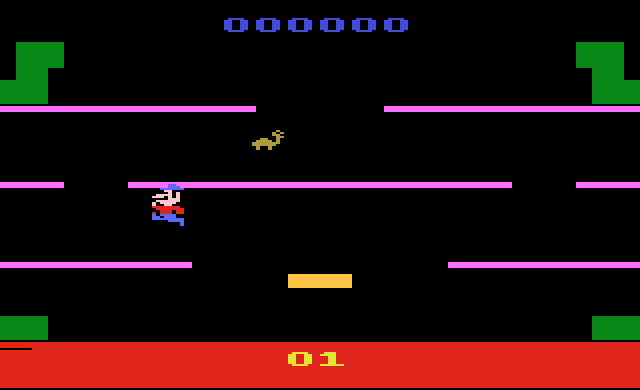 Mario Bros. (Atari, 1983)
Mario Bros. (Atari, 1983)
Like most Atari-released ports of arcade games, Mario Bros. replicates the gameplay of the original as best as it possibly can. However, it also exposes the technical limitations of Atari 2600 ports more than most. As you can probably gather from the title, Mario Bros. is something of a prototype of the epicness that would be Super Mario Bros. in a couple of years hence, albeit much more self-contained. It’s definitely a different game but many of the same elements are there: hitting enemies from below, gathering coins, kicking turtles while they’re down, etc. Much of the difficulty of the arcade game is lost in translation – the result, I can only guess, of the system’s limited sprite capability. Mario also pauses awkwardly at the end of a jump, which is slightly jarring. Give Atari credit, though, for including the coin-collecting bonus rounds. There are also plenty of game variations (including games with and without fireballs and a choice of three or five lives) which may be somewhat unnecessary as the most difficult variations are not terribly hard to begin with. Mario Bros. is good fun, but I don’t feel it quite captures the spirit of the original as well as Dig Dug or Ms. Pac-Man – both of which I happily group with their arcade predecessors and technically-superior ports in spite of their relative ease. B-
More Info: Mario Bros. on AtariAge. For current listings of Mario Bros. for sale on eBay, click here
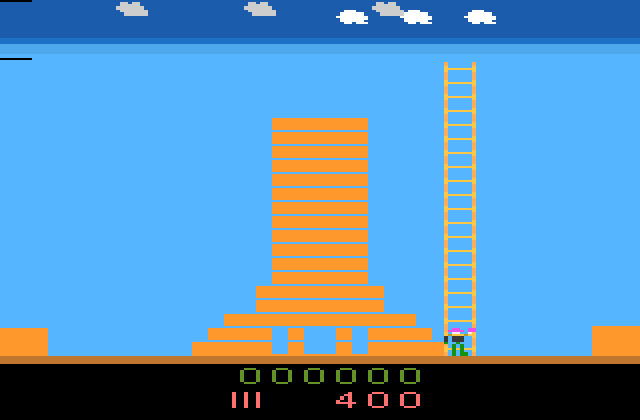 Master Builder (Spectravision, 1982)
Master Builder (Spectravision, 1982)
Was this really a commercially-released cartridge? I’ve played prototypes – lots of them in fact – that are far more playable than Master Builder. In fact, the most enjoyable thing about the game is the demo mode, which makes the game look far more fun than it actually is. Admittedly, the premise of the game does not inspire a lot of hope; I suppose a game that has you memorize basic blueprints and then construct a building could be kind of fun, but it would have to actually work. Instead, Master Builder is a nightmare of trying to lay blocks but picking them up instead, picking up blocks when you want to lay them, a ladder that gets in the way half the time, and overall just garbage controls. A day on the job at an actual construction site may very well be more fun, and I’m not even exaggerating.
The game packaging aggressively hawks the Spectravideo “Quickshot Deluxe Joystick,” making me wonder if the company purposely made the game virtually unplayable with the standard 2600 joystick in order to boost sales of its own product. Let’s just say you’d have to be one heck of a dedicated VCS fan (as opposed to collector) to hunt down this undoubtedly-rare controller just to play this incredibly-rare game. It’s simply not worth the effort. F
More Info: Master Builder on AtariAge. For current listings of Master Builder for sale on eBay, click here
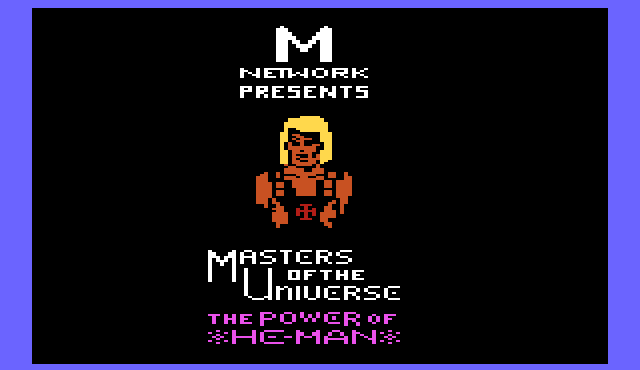 Masters of the Universe: The Power of He-Man (M Network, 1983)
Masters of the Universe: The Power of He-Man (M Network, 1983)
I’ve had a lot of recent experience with Masters of the Universe: The Power of He-Man thanks to its placement in a recent AtariAge High Score Club competition. It was a strange experience because throughout the two-week contest my opinion of the game wavered wildly between “This is a top-notch game” and “Meh.” Playing it again today I felt much the same.
Masters of the Universe features two distinct modes of gameplay. The first is a Defender-style side-scrolling shooter where you fly your Wind Raider to Castle Greyskull while dropping bombs on Evil Warriors and shooting down their Warp Trakkers and energy bolts. Once you reach the castle you face off against Skeletor (kind of) by making your way through gaps in two moving walls even as the bad guy shoots energy bolts at you. You can protect yourself from these bolts by drawing your sword. Don’t expect a sword fight between yourself and Skeletor, however; once you reach the other end of the room you’re treated to a splash screen with a wonderfully-illustrated He-Man, then returned to the first screen at a higher difficulty.
The Defender segment of the game suffers from one-buttonitis. In other words, once an enemy fires a Warp Trakker at you, you can no longer drop bombs with the action button but instead can only fire your ion cannon horizontally at the projectile. This is an awkward contrivance that wouldn’t be necessary if the 2600 controllers had an extra button. This is not the fault of the programmers, mind you, but then again programming around the system’s limitations is often the difference between a good game and a mediocre one. The moving walls portion is tedious at first but gets better as you identify the patterns in which the walls move.
Masters of the Universe is a playable, mostly-enjoyable game but it has just a few too many flaws for a strong recommendation. C
More Info: Masters of the Universe: The Power of He-Man on AtariAge. For current listings of Masters of the Universe: The Power of He-Man for sale on eBay, click here
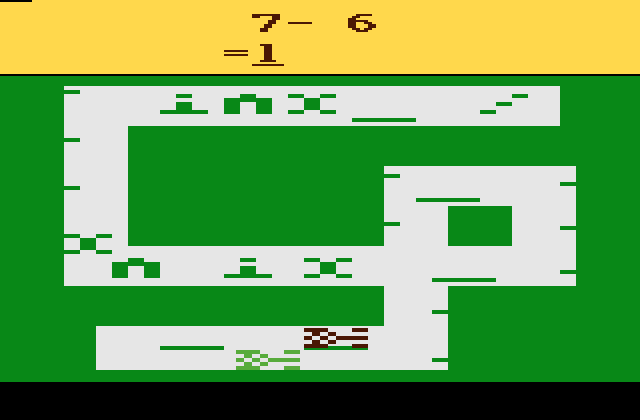 Math Gran Prix (Atari, 1982)
Math Gran Prix (Atari, 1982)
There’s a unique brand of pathetic associated with sitting around on a Sunday morning playing a 35-year-old educational game intended for elementary children. That’s appropriate because Math Gran Prix is kind of pathetic, and was likely just as much so back in 1982.
Let’s just talk about educational games for a second. What, exactly, does it mean to be an educational game? Personally, I think there are a number of games that do not strictly qualify as learning tools that can be educational. Think about the problem-solving involved in a game like Adventure: how do you complete your quest while only being able to carry one object, even though technically you need all of the objects at one time or another? To me, that stimulates creativity and critical thinking that can be useful throughout one’s life. More importantly, it does so while still being entertaining.
By contrast, Math Gran Prix – rather than make its case for improving basic math skills in the context of fun – just feels like an extension of the classroom. Players round a minimal race track by answering various math problems correctly with the problems increasing in difficulty as they answer questions correctly (conversely, the problems become easier for those who struggle with the questions). Landing on certain objects can push players up extra spaces or cause your computer or human opponent to miss a turn.
Math Gran Prix is not mechanically sound. Thanks to its shoddy graphics (even by 1982 standards), it’s hard to measure the game by spaces, which is key because the game asks you how many spaces you want to go before presenting the math problem. The cars are big and ugly, as are the special objects. Considering the game wasn’t fun back in 1982 and would undoubtedly be even less fun to kids today, Math Gran Prix will only appeal to collectors and nostalgia buffs in 2017. D-
More Info: Math Gran Prix on AtariAge. For current listings of Math Gran Prix for sale on eBay, click here
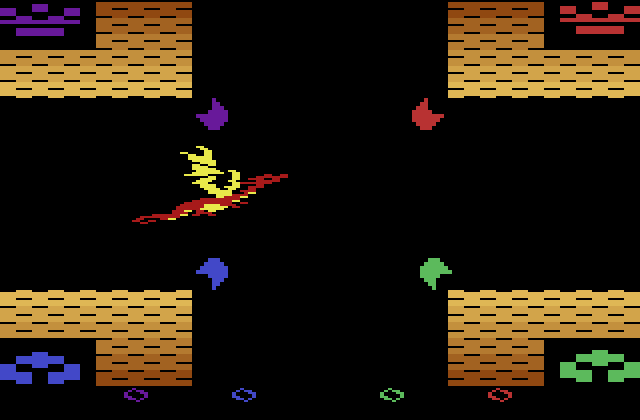 Medieval Mayhem (Homebrew, 2006)
Medieval Mayhem (Homebrew, 2006)
First things first: the graphics designed by David Vazquez in this 2006 update of Warlords are simply breathtaking and the animation is beyond belief for a 2600 game. My only complaint (although it’s a big one) is that unlike Atari’s 1981 Warlords cartridge, Medieval Mayhem isn’t very playable as a one-player game.
Although there is technically a one-player mode, the way your computer opponents behave is quite different from the original. In Warlords there were some tricks and handicaps you could use to beat the computer AI, but in this homebrew the response is binary: in catch mode, the knight you’re trying to attack will always follow your motions, meaning he will always either catch or deflect your ball. This makes it extremely hard to even take a block out of their shields, let alone win. I also found the settings a little suspect; anytime I disabled the computer opponents’ ability to catch, they seemed to be able to do so anyway.
Medieval Mayhem is a prime example of some key differences between homebrews and the old mass-marketed cartridges. Homebrews are frequently made by hardcore gamers for hardcore gamers, while the old games typically accommodated players of all skill levels and situations – Atari and Activision were particularly good at making sure every member of the family got the most bang for their buck. I’m not saying one approach is bad and the other good – it just sometimes makes it difficult to compare the old games with the new homebrews in the same context.
I’m giving Medieval Mayhem a B for the graphics and my assurance that it’s a blast in multiplayer mode (hey, it’s Warlords – how can you go wrong?). However, give it a pass if you do not have any Atari enthusiasts in your vicinity to play with. You can buy Medieval Mayhem at the AtariAge Store.